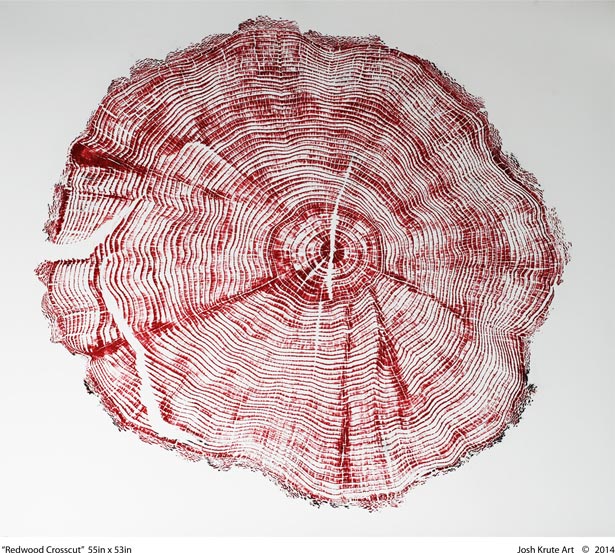
Josh Krute likes wood — I mean, he really, really likes it. We sat in a coffee shop (at a wooden table, of course) and he ran his hands over the tabletop’s grain, sputtering off details about it with a pretty serious expression on his face.
“In the last six or seven years, I’ve been printing sections of wood,” he explains. “I’ve been transferring their grain patterns onto paper — a process called relief.”
Krute’s a Western State Colorado University graduate with a degree in printmaking, but he’s also been dabbling in woodworking for several years (see EW’s story “Man vs. Nature,” May 2013). He can tell which tools make what marks on a tree — a dialogue between man and flora.
For the past two years, Krute has focused on one question: If trees could tell their stories, what would they say? Krute and a team of two additional artists, plus his mum, are collaborating on a project to create a life-size print cross-section of the country’s largest known tree — the Fieldbrook Giant of Eureka, California.
The giant, a redwood about 390 feet tall (well over 30 stories high), was cut down in 1890 and is estimated to be 1,100 years old; its stump measures 35 feet across. The tree was witness to a fundamental part of Pacific Northwest culture, as well as its own downfall: logging.
Logging has two pretty defined sides, it seems. People do it or people hate it. Pacific Northwesterners know the ups, downs, pros, cons and historical and environmental impact of logging. Since Krute mostly works with salvaged wood from trees that used to be in the forest and aren’t anymore, he’s had to consider things like the effects of logging, the environment and local communities.
 |
| Redwood Crosscut, 55 inch x 53 inch, by josh Krute |
The Fieldbrook Giant project sums up the dynamics between the good and the not-so-good of the industry. Krute stumbled upon the tree while researching a new subject of interest. He headed down to Eureka in search of the giant and found that the locals were unaware of this treasure in their backyard.
“Going to this historical society in Eureka, doing research and looking things up in their public library,” Krute says, “that’s been really interesting.”
The tree has played a big part in the town, even if the knowledge of its existence was lost through the years. Digging through archives, Krute came upon old lithograph prints of items that were sold in the Stump House, a small shop that the tree was physically a part of, and he discovered that Eureka resident Eric Hollenbeck had a crosscut slab of the tree that measures 13 feet tall and 12 feet wide. Because the original stump has too much decay for a print, Krute will use this section for printing.
“You try to imagine where these trees came from,” Krute says. “Each one of these trees has its own story, its own narrative.”
When a tree is cut, its history reveals itself. The growth rings give a general age range and the type of cut reveals what tools were used. Krute’s work focuses on the space between natural environment and its destruction.
Whether from a historical or environmental perspective, Krute says these prints can bring to life the importance of conservation. He hopes to see them one day in a museum like the Smithsonian.
Krute and the team head to Eureka to create the giant prints at the end of June. To follow the project, go to joshkruteart.com.